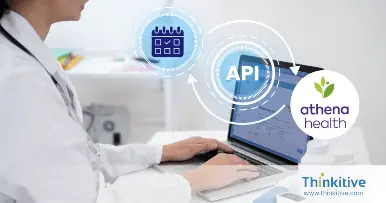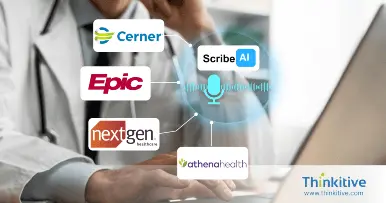EPIC EHR INTEGRATION
Why Do You Need EPIC EHR Integration for Your Practice?
Integrate your systems with EPIC EHR to unlock smarter team performance. Eliminate data silos, improve interoperability, and automate routine tasks to boost efficiency.
Unified Systems
Unify disconnected systems across the globe for connected care delivery
15 Countries
Process Efficiency
Eliminate manual data entry to improve efficiency
40% More Efficient Process
Proven ROI
Practices reported revenue boosts through automation and integration
27% Revenue Increase
CUSTOM EPIC INTEGRATION SERVICES
Our End-to-End Integration Services
Make your healthcare software solution interoperable and allow them to interact with each other easily and effectively with our complete custom EPIC EHR integration services.
Epic EHR Integration Consultation
- Integration Planning & Assessment
- Technical Strategy
- Workflow Optimization
- Training & Change Management
- Testing & Go-Live Support
Access to Epic Sandbox & Production Environments
- Vendor Communication
- Sandbox Setup
- API Authentication & Security
- Validation & Testing
- Production Access
Epic EHR Integration Services
- Epic APIs & Web Services
- App Orchard Integration
- FHIR, HL7, and CCDA Integration
- Interface Engine & Middleware
- Custom Development & Support
Let’s Get Started With Your EPIC EHR Integration?
Get started by accessing your system and let’s start your digital transformation journey into a connected healthcare ecosystem.
EPIC EHR INTEGRATION BENEFITS
Before & After EPIC EHR Integration
EPIC EHR INTEGRATION SOLUTIONS
How we Integrate Your Healthcare System with Epic
1. Streamline Your Clinic by Connecting with Epic
Our team of healthcare integration experts specializes in building secure, scalable, and customized interfaces with Epic EHR. We begin by understanding your unique requirements ranging from secure Epic data exchange needs and workflow optimization to desired functionalities and compliance goals.
Once requirements are defined, our architects design a tailored integration framework that ensures scalability, interoperability, and long-term maintainability. We leverage multiple integration methods including Epic APIs, HL7 messaging, App Orchard integration, and middleware-based synchronization to ensure seamless communication between your systems and Epic EHR.
Before deployment, we conduct rigorous testing to validate performance, accuracy, and security across data flows. Finally, our implementation team manages the transition from testing to production, ensuring a smooth go-live and minimal workflow disruption.
2. Custom EHR Integration Bridge Enables Epic Integration
We’ve developed a robust, ready-to-deploy middleware framework that serves as a secure bridge between your healthcare platform and Epic EHR. This bridge retrieves data from Epic, standardizes it, and converts it into a unified API that can be easily mapped to your application or internal systems.
Our universal data converter supports multiple healthcare data formats—FHIR, CCDA, HL7v2, TXT, CSV, and EDI—ensuring a complete Epic interoperability solution. Built on a microservices-based architecture, the system is containerized for scalability, with each high-load service supported by a dedicated database for optimal performance.
We follow stringent security protocols, including HTTPS (SSL) encryption, role-based access control, and secure vault storage for all keys and tokens. Every interaction is logged with detailed audit trails to ensure compliance, transparency, and accountability across all integration layers.
3. Mirth Connects Your Practices with Epic
Our integration specialists leverage Mirth Connect to establish seamless, bi-directional data exchange between Epic EHR and external healthcare systems. We rapidly configure Mirth channels to translate and process messages in diverse formats such as HL7, XML, CCD, DICOM, EDI, and NCPDP, ensuring full interoperability across your ecosystem.
We build secure integrations between Epic EHR, HIS, Telehealth networks, PMS, LIMS, and RIM systems, enabling consistent and synchronized information flow. Mirth Connect supports multiple communication protocols—TCP/IP, LLP, and HTTP/SOAP connectors—which our team expertly configures to match your system architecture.
By setting up endpoint connections, authentication parameters, and interface-specific configurations, we ensure reliable, real-time, and secure Epic data exchange. Additionally, we implement Mirth’s monitoring and logging capabilities to maintain transparency, track message flows, and proactively identify integration issues.

See How Can Custom Epic EHR
Integration Pay for Itself?
EPIC EHR INTEGRATION PROCESS
Custom Epic EHR Integration Process
Process
Requirement Analysis
Identify integration goals, data exchange needs, and workflow objectives to align Epic EHR connectivity with your clinical operations.
Evaluate Integration Capabilities
Assess Epic FHIR API resources and interoperability tools to determine the most efficient and secure integration approach.
Design & Develop Integration Interface
Architect and build custom interfaces or middleware that enable seamless communication between Epic EHR and external systems.
Build & Test
Implement integration components and rigorously test for data accuracy, security, and compliance with Epic EHR standards.
Go Live
Deploy the validated integration in the production environment and ensure smooth, secure, and uninterrupted system performance.
Let’s Integrate Your Epic EHR Integration
Get your first free consultation and uncover how EPIC custom integration can change your practice.
Case studies
Sneak-Peek into Our Successful Epic Custom Integration Projects
Explore how our tailored Epic EHR integrations have streamlined workflows, improved data exchange, and enhanced clinical efficiency for healthcare organizations.
CUSTOM EPIC INTEGRATION PLANS
Hire Epic EHR Integration Experts
Choose an engagement model that suits your specific Epic EHR integration needs and ideally fits your budget. We have a flexible model that accommodates according to your needs.
Time & Material Model
Ideal for evolving requirements. Pay only for completed work as project scope and milestones adjust dynamically throughout development.
Hire Dedicated Team
Best for extending your in-house team with skilled remote professionals. Choose resources, interview or trial them, and pay hourly based on utilization.
Fixed Price Model
Suitable for projects with a clearly defined, unchanging scope. Fixed cost and timeline. Best recommended for smaller, well-documented projects.

Why Thinkitive is The Best Epic EHR Integration Company for You?
![]() Tailored to your Needs
Tailored to your Needs
Thinkitive’s first step to developing ... customizable EHR software is to understand your unique needs and requirements. Based on that, our development team develops a customized software solution to meet your requirements and solve your problems.
![]() Ready-to-use Components
Ready-to-use Components
With our ready-to-use technology ...components like video conferencing, appointment, scheduling, and SOAP notes, fasten your custom EMR software development process.
![]() Third-Party Integration
Third-Party Integration
Integrate your EHR software system with ... multiple third-party systems like Telemedicine, RPM Devices, Labs, Radiology, etc., to build a complete virtual healthcare ecosystem.
![]() Affordable EHR Solutions
Affordable EHR Solutions
With our ready-to-use base EHR ...software framework, we give you an affordable custom EHR software solution specifically designed for your healthcare practice.
![]() In-Depth Domain Expertise
In-Depth Domain Expertise
With our ready-to-use base EHR ...software framework, we give you an affordable custom EMR software solution specifically designed for your healthcare practice.
![]() Timely Delivery
Timely Delivery
We have curated an EHR system ...development process that covers all the aspects of your healthcare practice’s unique needs and requirements with transparency for on-time delivery.



